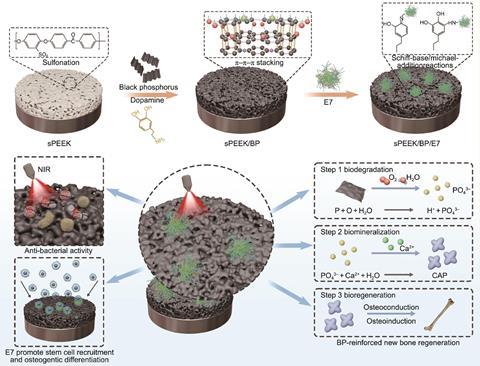A research team from Shanghai Jiao Tong University has resulted in a significant advancement in the field of orthopedic implant materials. The study, published in Engineering, introduces a novel polyetheretherketone (PEEK)-based implant material that not only promotes bone growth but also possesses potent antibacterial capabilities. This breakthrough could revolutionize the way bone implants are designed, improving patient outcomes and reducing postoperative complications.

PEEK has long been recognized for its excellent biological properties and compatibility with human bone tissue. However, its limited osseointegrative and antibacterial properties have hindered its broader clinical application. To overcome these challenges, a team of researchers, including professor Hongyan Chen and professor Xinquan Jiang, developed a multifunctional PEEK-based implant material that integrates effective osteogenesis and strong disinfection properties.
READ MORE: Infection-resistant 3D-printed metals developed for implants
READ MORE: Oxygen vacancy boosting Fenton reaction helps to fight bacterial infection in bone scaffold
The innovative material, named sPEEK/BP/E7, is a result of the self-assembly of black phosphorus (BP) nanosheets, mussel-inspired polydopamine (PDA), and bioactive short peptide E7 on sulfonated PEEK (sPEEK). This versatile micro-/nano-structured PEEK surface offers superior hydrophilicity and a favorable osteogenic microenvironment, along with excellent photothermal effects under near-infrared (NIR) irradiation.
Antibacterial activity
In vitro tests have demonstrated that sPEEK/BP/E7 exhibits enhanced cytocompatibility and osteogenicity, outperforming traditional sPEEK and sPEEK/BP samples in terms of cell adhesion, proliferation, alkaline phosphatase (ALP) activity, matrix mineralization, and osteogenesis-related gene expression. Moreover, the multifunctional coating has shown strong antibacterial activity against Staphylococcus aureus (S. aureus) and Escherichia coli (E. coli), two common pathogens in implant-related infections.

The study’s findings were further confirmed in a rat femoral infection model, where sPEEK/BP/E7 effectively resisted S. aureus infection under NIR light irradiation and promoted osseointegration in vivo. This indicates that the sPEEK/BP/E7 implant could provide controlled photothermal antibacterial effects and facilitate the recruitment of bone marrow stem cells (BMSCs) for osseointegration and bone regeneration.
The development of the sPEEK/BP/E7 implant material offers a forward-looking solution for implant designs, providing a new idea for the application of PEEK-based materials in the field of bone repair. By incorporating both biochemical and photothermal cues, this innovative implant not only enhances osseointegration but also significantly lowers the risk of postoperative infections.







No comments yet